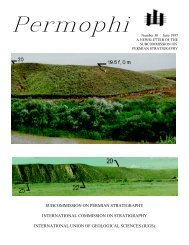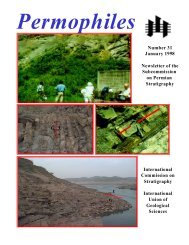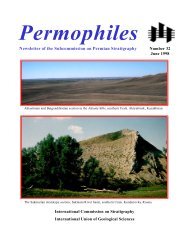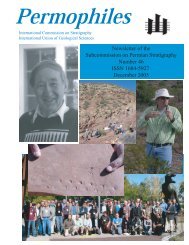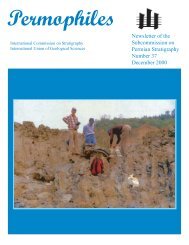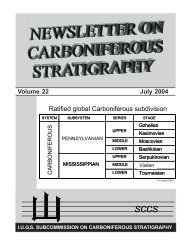Permophiles
Permophiles
Permophiles
Create successful ePaper yourself
Turn your PDF publications into a flip-book with our unique Google optimized e-Paper software.
Karatau Fault and widens southward where the foredeep stratabecome covered by Mesozoic/Cenozoic strata and merge in thesubsurface with upper Paleozoic strata of the Pre-Caspian Basin(Figure 1B).Volcanic ash horizons are widely distributed in the southernUral foreland, and are present in many of the classic late Paleozoicsections of the region. Most ash layers are easily recognizedin the field because of their striking colors, includingyellow-brown, red-brown and various shades of green. Theirthickness varies from 1 to 20 cm. Both lower and upper contactsof volcanic ash layers are sharp, generally planar, and can beclearly determined. The tuffaceous material is altered and poorlyconsolidated, making them weather recessively relative to thesurrounding clastic and carbonate strata. Most of volcanic ashlayers have a distinctive soft, soapy texture. The most probablevolcanic source for the ash layers in the southern foredeep is theeastern part of Tagil- Magnitogorsk arc, where Permian dikes andhypabyssal silicic and alkaline intrusions cut marine Visean andSerpukhovian sediments (Chervyakovsky, 1978; Mizens, 1997).Thin but widespread air-fall volcanic ash layers form potentiallyimportant stratigraphic markers in the offshore facies of thePennsylvanian- Cisuralian of the Preuralian Foredeeep Basin.Preservation of volcanic ash in the southern Pre-Urals wasstrongly influenced by depositional environment. Specifically,volcanic ash deposited in relatively deep environments (middleramp, outer ramp, basin) had a high preservation potential. Ashbeds deposited at inner ramp positions were highly affected byreworking and erosion.As a part of ongoing research in the southern Urals, we havesystematically sampled several key sections in the region formultitaxa paleontology. Our sampling strategy included the collectionof volcanic ashes for radiometric age control. However,during the processing of relatively small (1.0-1.5 kg) preliminaryash samples for zircon recovery, we noted the presence of wellpreservedconodonts in many samples. Consequently, we beganto empirically derive methods that would allow simultaneous recoveryof zircons and micropaleontologic materials from the ashes.We collected volcanic ash beds within mid-ramp carbonate as wellas offshore mixed carbonate-siliciclastic successions in three sections:1) Usolka, 2) Dal’ny Tulkas Road Cut, and 3) Dal’ny TulkasQuarry (Figures 1B, 3, 4).First, the surface of volcanic ash beds were cleaned to avoidcontamination from loose surficial material (Figure 3A). Next, about10-15 kilogram (sometimes up to 30 kg) of volcanic ash materialwas carefully collected with shovel and/or ice axe. We used largeplastic bags to hold the collected material to prevent contamination.Field processing was conducted to reduce sample weight andvolume, and create a preliminary concentrate. Most of the materialin the ash horizons has weathered to various clay minerals (up to80-90 %). Each sample was placed in a 15-gallon plastic tub withclean water. The water was carefully taken from the Usolka River toavoid any suspended contaminate material. Samples were thenworked by hand to disintegrate lumps and generate a suspensionof clay in the water. Clay rich water was decanted out and the tubwas refilled with fresh clean water. This step was typically iteratedthree to four times per sample. After most of the clay was washedout, samples were wet sieved with # 4 (5 mm) and # 30 (0.6 mm)sieves. At this point, samples mass was usually reduced to 2-8 kg.Samples were then placed in labeled plastic buckets. Diluted 10-<strong>Permophiles</strong> Issue #39 20011515% acetic acid was added to remove all dissolvable (perhapsprimarily carbonate) material. To avoid possible loss of materialdue to sometimes-vigorous reaction, we added acid with greatcare. Samples were left in the acid bath for approximately one dayand then washed with fresh water. Sample weights were commonlyreduced to 1-5 kg, depending on the carbonate component in eachsample. Next, an initial density separation was conducted using a14-inch gold pan. Relatively high-density material was concentrateduntil samples were reduced to 0.3-0.5 kg. Samples were thenair-dried and placed into labeled ziplock plastic bags for transportto the lab.Initial processing in the lab commonly included a second 10-15% acetic acid bath for 3-5 days. After the reaction stoppedcompletely, liberated clay was washed from the samples. After thesecond acid bath, sample weights ranged from 0.1 to 0.4 kg. Next,samples were placed in an ultrasonic bath to further disintegratepolygranular aggregates. Each sample was placed with clean waterinto a glass container and exposed to the ultrasonic agitationfor one to three days. Clay and other light fractions were decantedperiodically and replaced with clean water until no additional claysuspended material was generated. At this stage, sample weightswere reduced to 0.01 to 0.1 kilogram. Fe-bearing minerals were thenFigure 3. Volcanic ash bed at the D. Tulkas quarry section, bed17.9 mab (A) and heavy mineral fraction laden with conodontsrecovered from this ash bed (B).





